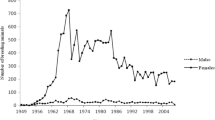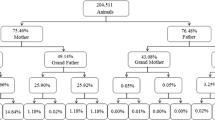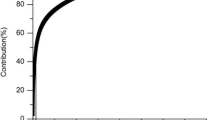Abstract
Reyna Creole cattle originated from Bos taurus cattle brought to Latin America during the Spanish colonization in the fifteenth century and are the only remaining local breed in Nicaragua. However, the current genetic status of this breed is unknown. Therefore, the population structure of three recorded Reyna Creole herds in Nicaragua was studied to estimate their level of inbreeding, effective population size, and generation intervals. Data from 2,609 animals born between 1958 and 2007 were analyzed. A pedigree completeness index higher than 0.8 was required to obtain reliable estimates of the level of inbreeding, and this criterion was met for 367 animals (14%) in two herds. The average level of inbreeding was 13.0%, with values ranging from 0% to 43.8% for individual animals. One of the herds had an average inbreeding level of 21.6%, primarily due to long periods in which the same bulls were used for mating, leading to excessive frequencies of matings between closely related animals. The effective population size differed between years and ranged from 28 to 46 animals, showing that the Reyna Creole cattle breed is endangered, close to critical status. The average generation interval was 6.9 years with values as high as 19.1 years for some sires that were used for artificial insemination over a long period of time. Due to the high level of inbreeding and small population size, urgent actions are required for the development of a breeding program to protect the breed and support its sustainable utilization.
Similar content being viewed by others
References
Alderson, L. 2009. Breeds at risk: Definition and measurement of factors which determine endangerment, Livestock Science, 123, 23–27.
Caballero, A. 1994. Developments in the prediction of effective population size, Heredity, 73, 657–679.
Casas, E. and Tewolde, A. 2001. Evaluación de características relacionadas con la eficiencia reproductiva de genotipos criollos lecheros en el trópico húmedo, Archivos Latinoamericanos de Producción Animal, 9(2), 63–67.
Corrales B., C.R. 1993. Criterios Técnicos de Conservación y Utilización de Ganado Criollo (Reyna) en Fincas Lecheras o de Doble Propósito en el Trópico Seco de Nicaragua. (Unpublished Master Science Thesis, Centro Agronómico Tropical de Investigación y Enseñanza, Turrialba, Costa Rica). http://orton.catie.ac.cr/orton.htm.
Dahlin, A., Khan, U.N., Zafar, A.H., Saleem, M., Chaudhry, M.A. and Philipsson, J. 1995. Population structure of the Sahiwal breed in Pakistan, Animal Science, 60, 163–168.
De Alba, J. 1985. El Criollo Lechero en Turrialba, Turrialba, Costa Rica, Centro Agronómico Tropical de Investigación y Enseñanza, Boletin Técnico No. 15.
De Alba J. and Kennedy, B. W. 1985. Milk Production in the Latin-American Milking Criollo and its crosses with the Jersey, Animal Production, 41, 143–150.
Falconer, D. S. and MacKay, T. F. C. 1996. An Introduction to Quantitative Genetics, (Longman, London).
Food and Agriculture Organization, 2004. Informe sobre el estado de los Recursos Zoogenéticos de Nicaragua. Reporte de país. ftp://ftp.fao.org/docrep/fao/010/a1250e/annexes/CountryReports/Nicaragua.pdf
Food and Agriculture Organization, 2007. The State of the World's Animal Genetic Resources for Food and Agriculture. Edited by Barbara Rischkowsky & Dafydd Pilling. Rome.
INEC, 2003. Censo Nacional Agropecuario (CENAGRO III). Instituto Nacional de Estadísticas y Censos, Managua, Nicaragua. http://www.inide.gob.ni/cenagro/perfiles.htm
INETER, 2006. Resumen Meteorológico Anual. Estaciones: 69070, 69129, 69115, 69027. Instituto Nicaragüense de Estudios Territoriales, Managua, Nicaragua. http://www.ineter.gob.ni/Direcciones/meteorologia/index.html
MacCluer, J. W., Boyce, A. J., Dike, B., Weitkamp, L. R., Pfenning, D. W. and Parsons, C. J. 1983. Inbreeding and pedigree structure in Standardbred horses, Journal of Heredity, 74, 394–399.
Martinez D., R. A., Garcia, D., Gallego, J. L., Onofre, G., Perez, J. and Cañon, J. 2008. Genetic variability in Colombian Creole cattle populations estimated by pedigree information, Journal of Animal Science, 86, 545–552.
Mekonnen, H. M. and Philipsson, J. 1994. Estimates of genetic and environmental trends of growth traits in Boran cattle. In: Genetic Analysis of Boran, Friesian and Crossbred Cattle in Ethiopia, Ph.D. Thesis, Swedish University of Agriculture Sciences.
Pereira, M. C., Zerlotti, M., M. E., Galvao de Albuquerque, L. and Razook, A. G. 2005. Estimativa de Ganho Genético a Partir de Diferenciais de Seleção e Parâmetros Populacionais em um Rebanho Caracu, Revista Brazileira de Zootecnia, 34(6)(Suplemento), 2245–2252.
Primo, A. T. 1992. El ganado bovino Ibérico de las Américas: 500 años después, Archivos de Zootecnia, 41(extra), 321–432.
Ruiz F., A. 1992. Determinación de niveles críticos y efectos de consanguinidad sobre características productivas, reproductivas y de crecimiento en ganado Criollo Lechero Centroamericano y Romosinuano bajo condiciones de trópico húmedo, (Unpublished Master Science Thesis, Centro Agronómico Tropical de Investigación y Enseñanza, Turrialba, Costa Rica). http://orton.catie.ac.cr/orton.htm
Russell, N.D., Rios, J., Erosa, G., Remmenga, M.D. And Hawkins, D.E. 2000. Genetic differentiation among geographycally isolated populations of Creole cattle and their divergence from other Bos taurus breeds, Journal of Animal Sciences, 78, 2314–2322.
Salgado F., D. 1988. Indices de Selección y Evaluación de su Efectividad para Características Relacionadas con la Producción de Leche en el Trópico, (Unpublished Master Science Thesis, Centro Agronómico Tropical de Investigación y Enseñanza, Turialba, Costa Rica). http://orton.catie.ac.cr/orton.htm
Sigurdsson, A. & Arnason, Th. 1995. Predicting genetic trend by uni- and multitrait models. Acta Agriculturae Scandinavica, Section A., Animal Science, 45, 1–10.
Silva, M. V. G. B., Ferreira, W. J., Araujo, C., J., Paes, G., G. & Palma de Oliveira, P. R. 2001. Efeito da Endogamia sobre Características Produtivas e Reprodutivas de Bovinos do Ecótipo Mantiqueira, Revista Brazileira de Zootecnia, 30(4), 1236–1242.
Sirkkomaa, S. 1983. Calculations on the decrease of genetic variation due to the founder effect, Hereditas, 99, 11–20.
Ulloa, G., Alba J., De. 1957. Resistencia a los parásitos externos en algunas razas de bovinos, Turrialba, 7, 8–12. http://orton.catie.ac.cr/revis.htm
Villasmil-Ontiveros, Y., Aranguren-Mendez, J., Román, R., Isea, W., Contreras, G., Zambrano, S. and Jordana, J. 2008. Pedigree analysis in Criollo Limonero, Revista Cientifica, FCV-LUZ, XVIII, 3, 284–290.
Wang, J and A. Caballero. 1999. Development in Predicting the effective population size of subdivided populations, Heredity, 82, 212–226.
Wright, S. 1922. Coefficients of inbreeding and relationship, The American Naturalist, 56, 330–338.
Acknowledgement
The authors would like to greatly acknowledge the Reyna Creole cattle farmers in Nicaragua for making the data of their herds available for this study. Financial support has been provided by the Swedish International Development Agency (SIDA) which is gratefully acknowledged.
Author information
Authors and Affiliations
Corresponding author
Rights and permissions
About this article
Cite this article
Corrales, R., Näsholm, A., Malmfors, B. et al. Population structure of Reyna Creole cattle in Nicaragua. Trop Anim Health Prod 42, 1427–1434 (2010). https://doi.org/10.1007/s11250-010-9571-9
Accepted:
Published:
Issue Date:
DOI: https://doi.org/10.1007/s11250-010-9571-9




